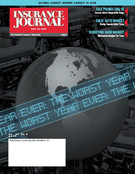You’re leaving money on the table, and there are savings to be added if you’re willing to spend some energy looking for it.”
Those are the sentiments of Alex Ho, consumer brand director for Progressive Insurance, in regards to the results of a recent study Progressive conducted, comparing auto insurance rates among companies. The study revealed “on average, people can save over $500 if they shop around,” says Ho.
According to the study, policyholders nationwide could save an average of $547 every six months by shopping around for auto insurance. Statewide, California residents could see a savings of $662, and Texans could save an average of $619. The study breaks the savings down even further by city.
Ho says, “the study falls under our general mission to continue to help consumers learn more about auto insurance and make smart decisions. The reason we do the study is, by and large, consumers continued to tell us that they don’t really understand how carriers arrive at rates.”
The data was derived from two sources. The first was information provided by policyholders when they called Progressive for a quote. That data was compared with the rate filings of other carriers, allowing Progressive to determine quotes from those companies as well—”over 90,000 people who came to us asking for a quote and rates of other insurers [in the] second half of last year,” Ho comments.
The second source of data was from an auto insurance shopping survey of “2,000 consumers… about habits and practices, which have indicated the majority of the consumers were not likely to shop for auto insurance, ” Ho continues.
“Most consumers state that they’re either skeptical that savings are going to be there, or they perceive the shopping process as difficult, hard to understand, or time consuming. The process doesn’t necessarily have to be that difficult.”
The reason for the variances may differ from state to state. In California, for example, premium variance can be attributed to a multitude of factors. Everything from driving record, age, where you live, how many kids you have, and how many cars you own all play into the determination of premiums.
“There’s a large variance in the rates from one company to another. I think different companies have different results in different areas,” says Steve Brooks, owner of Brooks Insurance Services in Thousand Oaks, California. “Certain companies just seem to have pockets of areas that they are more competitive in.”
Brooks offers a recent example in of his own customer’s premium increase significantly after moving only a matter of miles. SAFECO, he explained, used to be very competitive in Marina del Rey. Move one zip code over to Playa del Rey, and SAFECO became one of the highest companies.
“I think a lot of times they make their rates in different areas based just on their past results.” Brooks adds. “Each company decides where they want to be in the market, what niche they want.”
Brooks also points to the role that auto theft and insurance fraud play in premium variance. Theft, he says, isn’t as big a factor because it is covered by comprehensive, which is the smallest part of the automobile insurance policy.
He points too to the impact of locale—”You have a brand new BMW convertible, and you park it outside your house in Bakersfield, or you park it down on Florence and Normandy in South Central L.A. You’re telling me that doesn’t make a difference? It does make a difference,” he said.
Fraud, he said, “is a huge part of the insurance premium, in all types of insurance.” Brooks estimates the cost of fraud in California to be in the billions of dollars every year. “California is probably the insurance fraud capital of the world,” he says.
“Consumers are smart if they shop around. People can save a lot of money on insurance, especially in California,” he adds.
Premium variance in Texas is a different story, according to Hanna Ogle, agent and office manager for Southwest Insurance Center in Austin. “We’re kind of the ugly redheaded stepchild,” she says, attributing the reasons for premium variance to the unique rating system for insurance there.
Texas quotes insurance premiums through either rate regulated, or non-rate regulated companies. Rate regulated companies must follow the rules issued by the Texas Department of Insurance, which includes a benchmark under which companies may not go above or below 30 percent to set premium prices. Non-rate regulated companies, or county mutual companies, don’t have to adhere to the benchmark regulation and can set their rates at whatever price they wish.
“If you just take a random sampling of four different companies, if you’ve got two that are county mutual, and two that are rate regulated, you could see huge variences in prices,” Ogle says. She attributes the increase in premiums for renewals in the hard market to encourage people to go out and shop for insurance.
“Companies like Progressive… can go as far below or above benchmark as they want to; they don’t have to follow the rate regulations given by the insurance department. And so that’s why you’re seeing a huge variance in rates.”
In Texas, auto theft plays a big part of policy premiums, according to Ogle. She says the high-risk autos for theft like Toyota and Honda will have a higher rating than standard vehicles, such as Ford Taurus.
As for fraud, Ogle says, “I imagine it just depends on the area you are in. In Houston, or Dallas, you probably have the higher rates that occur in a big city.”
Whatever the reason for premium variance, there is still money to be saved if consumers shop around. The unique rating systems that each company uses define their target audience and determine their competitiveness in each area. Independent agents can thereby find them the lowest rate possible.
Was this article valuable?
Here are more articles you may enjoy.


 Viewpoint: Artificial Intelligence Is Rewriting the Rules for Commercial Lines
Viewpoint: Artificial Intelligence Is Rewriting the Rules for Commercial Lines  North Carolina Sting Operation Alleges Roofer Damaged Shingles to File Claim
North Carolina Sting Operation Alleges Roofer Damaged Shingles to File Claim  AIG Partners With Amwins, Blackstone to Launch Lloyd’s Syndicate Using Palantir
AIG Partners With Amwins, Blackstone to Launch Lloyd’s Syndicate Using Palantir  Senators Launch Probe Into Demotech’s Ratings in Florida
Senators Launch Probe Into Demotech’s Ratings in Florida 


